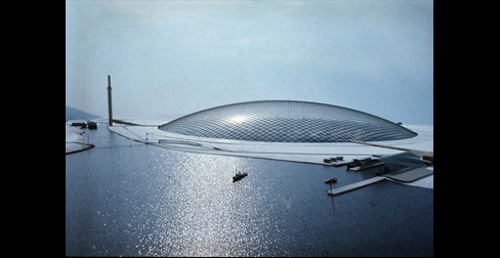-
By today’s standards, colonising a portion of the Arctic by encasing a city with its very own atomic power plant – under a PVC dome with a free span of two kilometres – might not sound like the most reasonable of urban planning proposals. But in 1971 it was the future. That year, responding to a commission by a Hoechst AG, a German chemical manufacturing company, Frei Otto and Ewald Bubner at Atelier Warmbronn, together with Kenzo Tange and Ove Arup developed the Arctic City study.
Formulating the proposal’s technical and construction requirements in extensive detail, the designers considered everything from the heating of the artificial atmosphere to the cooling of the power plant’s water systems, as well as analyses of the structure’s capacity to withstand extreme winds and heavy snow loads. It was actually built in April 1971 – albeit rather smaller and within the rather warmer climes of Germany – as a still huge 1:2000 scale model. Spanned across by PVC, foil and fishnet and sited within an Arctic landscape made from foam and Plexiglas, the model even utilises a blower system to produce the appropriate internal pressure.
Drawing upon the utopian ideals of Paul Sheerbart, Hans Scharoun, Bruno Taut et al, Otto, along with Buckminster Fuller, was an enthusiastic developer of light climate hulls, believing at the time that there would be roofed cities in the Arctic by the end of the twentieth century. I (Franzsika Stein)
Photo: Fritz Dressler
Sketch for an Arctic environment by Frei Otto. (Image: © ILEK, Stuttgart)
-
Search
-
FIND PRODUCTS
PRODUCT GROUP
- Building Materials
- Building Panels
- Building technology
- Façade
- Fittings
- Heating, Cooling, Ventilation
- Interior
- Roof
- Sanitary facilities
MANUFACTURER
- 3A Composites
- Alape
- Armstrong
- Caparol
- Eternit
- FSB
- Gira
- Hagemeister
- JUNG
- Kaldewei
- Lamberts
- Leicht
- Solarlux
- Steininger Designers
- Stiebel Eltron
- Velux
- Warema
- Wilkhahn
-
Follow Us
Tumblr
New and existing Tumblr users can connect with uncube and share our visual diary.
»Don‘t fight forces, use them.«
Richard Buckminster Fuller
Keyboard Shortcuts
- Supermenu
- Skip Articles
- Turn Pages
- Contents


